by Dorothea
Burstyn
(click on photos to enlarge image)
THREE IMPORTANT EXHIBITIONS FOR THE COLLECTORS OF MODERN
SILVER AND OTHER METALS
FRAUENSILBER, PAULA STRAUS, EMMY ROTH & CO,
SILBERSCHMIEDINNEN DER BAUHAUSZEIT
"Frauensilber, Paula Straus, Emmy Roth & Co.,
Silberschmiedinnen der Bauhauszeit" (Silver made by
women, Paula Straus, Emmy Roth & Co., Female
silversmiths in the time of the Bauhaus)
(note 1)
is a wonderful exhibition showing more than 180
objects, the majority from private collections and
now for the first time introduced to the public.
These female artists, many of them of Jewish origin,
had been forgotten due to the political
circumstances in the 1930s and 1940s. It is thanks
to Dr. Reinhard Saenger's considerable energy
dedicated to the research into the life and works of
these artists that their lasting legacy for German
silversmithing is now secured. The research proved
especially difficult. Archives had been destroyed in
WWII. Other private archives like the one of
Bruckmann & Söhne had simply been discarded as their
importance for the history of the German silver
industry was not fully recognized. Combing through
trade journals and other publications, working
through the papers of well connected art historians
like Karl Schwartz
(note 2), and last but not least finding
Paula Straus' portfolio dating to 1938 as well as
many other photos with her sister in New York City
led to many corrections and considerably advanced
our knowledge of the contribution of female
silversmiths of this period.
|
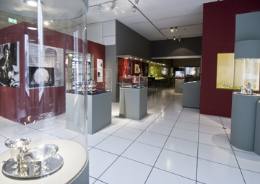
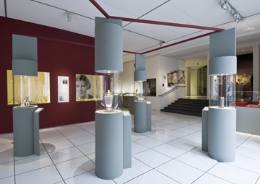
Exhibition halls at the
Badische Landesmuseum, Karlsruhe
|
At the beginning of the 20th century women had started to
take a place in silversmithing, traditionally a male dominated
trade. They were educated either in silversmiths' workshops or
in specialist schools for decorative art. Not hobbyists but
serious proponents of their trade, their aim was to establish
workshops and make a living with their art. To facilitate this
aim in the very trying economic climate of the 1930s some shared
studio space or joined artists' work groups. The "Frauensilber"
exhibition is the first extensive show of the fifteen most
important female silversmiths of Germany, Austria and
Switzerland. Most of them worked as jewelers but Paula Straus,
Emmy Roth and Christa Ehrlich beside some others started to make
silver tableware.
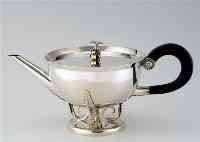
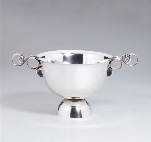

|

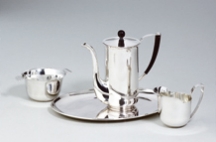
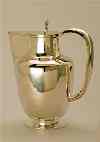
|
(upper row, left to right): Paula Straus,
teapot from Service 13161 for Bruckmann & Söhne,
1928; Paula Straus, fruit bowl, for Bruckmann &
Söhne, ca.1926; Emmy Roth, tea service 1926
(bottom row, left to right): Emmy Roth, sugar caster,
Berlin 1927; Christa Ehrlich, after dinner coffee
service; Erika Petersen, claret jug, 1933
|
Coming from a mostly traditional bourgeois background, they
found a new form language for their silverware. The result was a
definite No to the over laden and 'the everything matching'
silver table of their mothers and grandmothers. The center of
attention was now a plain, sometimes multipurpose object which
convinces by its useful form - a single vase, a candlestick, a
special box or a fruit dish. It is an amazing fact that these
artists produced silver pieces of the simple, elegant forms so
conducive for serial production at a time when the Bauhaus in
Weimar and Dessau, whose mission to produce prototypes for
industrial production was still in an experimental phase.
Therefore Paula Straus, Christa Ehrlich and Emmy Roth can be
called the first female industrial designers, whose designs for
Bruckmann & Söhne and the Zilverfabriek Voorschoten quickly
adapted to the demands of machine production.
The accompanying catalogue to the exhibition
(note 3), written by
Reinhard W. Saenger, with essays by Annelies Krekel-Aalberse,
Heidrun Jecht and Rüdiger Joppien, is a book which should be
found in the library of every collector of modern silver. It not
only gives - sometimes very movingly - biographies of the
various silversmiths, but its many illustrations form a
reference catalogue for good modern silver. Especially
interesting are the many included design drawings; the depiction
of the various master marks and the enclosed bibliography are
very useful. The sales figures for this catalogue are very
encouraging and the publisher is seriously thinking of printing
a second edition.
This exhibition is not only a spectacular success with
enthusiastic reviews in many publications, but it has also led
to new discoveries of Emmy Roth and Paula Straus' silver pieces
in private collections. Dr. Saenger in cooperation with the
Jewish Museum in Berlin has plans to not only introduce the
oeuvre of these two silversmiths to the American public with an
exhibition but also to publish his detailed research and
extensive hitherto unpublished picture material in form of an
illustrated monograph. I am sure to speak for all collectors of
modern silver when I hope that all these ambitious plans will
come to fruition.
A CENTURY OF SILVER AND METALWORK FROM THE
MARGO GRANT WALSH COLLECTION
A Century of Silver and Metalwork from the Margo
Grant Walsh Collection is showing at the San
Francisco International Airport, Terminal 2, from
April to October 2011. The SFO, established by the
Airport Commission in 1980 with the expressed wish
to humanize the airport environment, is a very
well-funded museum since it gets one and a half
percent of all landing fees and is able to invest in
high-end showcases, and display material and
maintain more than twenty galleries throughout the
airport terminals.
|
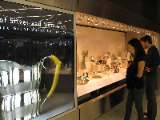
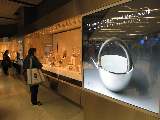
SFO Exhibition
|
Since retiring from a successful career as
interior architect from Gensler, Margo Grant Walsh
has dedicated herself to researching her large
collection of modern silver and metalwork and has
spent her time and energy to make it available to
the public. A generous donor, she has given the
Portland Museum over two hundred fifty pieces of
American and English silver and contributed
important pieces to the American Wing of the
Metropolitan Museum, NYC. Her collection has been
shown in five exhibitions in the last six years, one
of these in the entrance hall of the San Francisco
airport. The current show is placed beyond security
screening in the new Terminal 2, Departure Level
which proves to be a much better location - since we
all rush through the entrance halls of airports to
check in only to have hours of leisure after passing
security until boarding time - last month already
saw a high volume of visitors' traffic.
|
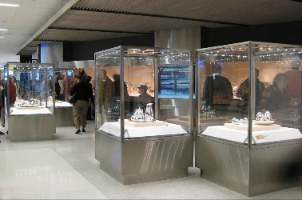
SFO Exhibition
|
For Margo Grant Walsh, form and style were
always the determining factors for her purchases -
this exhibition shows a good mix of works in silver,
copper and pewter. In the beginning Margo Grant
Walsh concentrated on collecting English and
American artists, favoring English works of the
Guild of Handicrafts, the Keswick School of
Industrial Arts and Liberty & Co., and American
metal work from the Kalo Shop, Clemens Friedell and
Dick van Erp to name only a few. But soon she
branched out to other countries recognizing that
great design and craftsmanship really knows no
borders. Here naturally she was drawn to silver
designed by famous architects like Josef Hoffmann
and Josef Maria Olbrich.
|
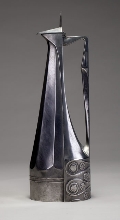
Pewter decanter by Josef Maria Olbrich
|
The show also expresses the growth of
Grant-Walsh's collecting activities. Her attendance
of the Goldsmiths' Fairs at London Goldsmiths' Hall
brought her in contact with many modern English
silversmith, many of which she counts now as her
friends.
The SFO exhibition includes examples of the
beautiful works of Wally Gilbert, Ane Christianson,
David Webdale, Katy Felton and Hiroshi Suzuki.
|

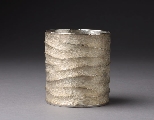
Two beakers by Wally
Gilbert (left)
Beaker by Hiroshi Suzuki, 2006 (right)
|
Scandinavian silversmiths are well represented,
Svend Weihrauch's tea service, made ca. 1948, with
its sinuous lines, is a definite eye catcher.
Italian designers had a lasting influence on silver
and metalwork of the 20th century, the hemispherical
teapot designed by Gabriele De Vecchi, 2006, and
other works by architect-designer teams for Milan's
San Lorenzo workshop are witness to this statement.
|
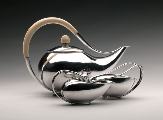
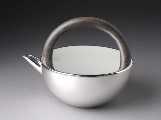
Tea service by Svend
Weihrauch, ca. 1948 for Frantz Hingelberg
Silversmithy (left)
Gabriele de Vecchi, teapot, 2006 (right)
|
Part of the collection is pictured in "Collecting by Design,
Silver & Metalwork of the Twentieth Century from the Margo Grant
Walsh Collection" (note 4).
The SFO Museum will undertake extensive photographing of this
show, which will hopefully be the basis for a new book showing
the many new additions to the Margo Grant Walsh collection.
HAKARO
The opening of the exhibition HaKaRo coincided with this year's
flatware collectors' meeting in the Deutsche Klingenmuseum,
Solingen (note 5).
Curating this exhibition are Heinrich Averwerser and Jörg
Müller-Daehn - a research team already well known for their
books on modern German flatware
(note 6). HaKaRo stands for Hans Karl Rodenkirchen, a
very versatile graphic artist and industrial designer and also
one of the early environmentalists. After buying an old mill on
the river Wupper, his concentrated efforts and the founding of
the environment group Nordrhein-Westfalen led eventually to
better regulations for industrial water use and consequently to
an improved water quality of this river.
Rodenkirchen together with his wife and business partner Lotte
not only made the old mill their home, it also became a cultural
center; a place for various exhibitions, concerts, theatre
performances and lectures. From 1954 to 1965 it served as studio
space of various artists who formed the "Werkring Wipperkotten".
This led to the establishment of a permanent gallery which sold
their various products as well as glasses, flatware and table
accessories designed by Rodenkirchen and executed by local firms.
The exhibits for this show were furnished by Heinrich Averwerser
and Lotte Rodenkirchen. There are an interesting number of
drawings and designs, mirrors and jewelry pieces, but
Rodenkirchen's flatware designs are naturally the main interest.
When Rodenkirchen began to design for the Solingen flatware
industry it had just recovered from the devastation of WWII. The
industry's adjustments of the artist's design vision and what
seemed feasible to produce with the existing machinery and
tooling created a constant conflict. Cost was the reason for
abolishing dinner- and luncheon flatware and the sole production
of a medium sized flatware type. The popularity of the
Scandinavian style made the Solingen firms seek out the sleek,
simple forms often devoid of decoration. Rodenkirchen’s designs
mostly fit with these industrial demands. Exceptional is the
forged flatware design for "Obelisk", 1961, executed by Paul
Wirths, Solingen, which takes its design inspiration from the
leaf of the rowan tree. Rodenkirchen also designed special table
accessories, which were mostly marketed in the Wipperkotten
Gallery. To mention a few examples are a set of napkin rings
decorated with semi-precious stones, special servers for chicken;
as well as the design for stainless steel party flatware for
Englert & Solvie, Mettmann.
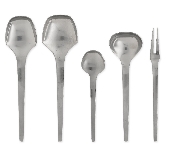
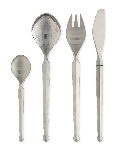
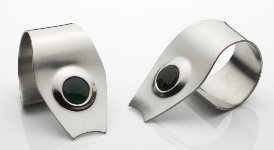

|
(left to right): 'Stavanger', Willi Drache,
Solingen, stainless steel, 1962;
'Obelisk', Paul Wirths, Solingen, stainless steel,
1961;
stainless steel napkin rings set with semi-precious
stones. Völker, Forst & Merten, Solingen
chicken servers, 1964, Völker, Forst & Merten,
Solingen
|
Brilliant were Rodenkirchen's designs for
children's flatware. Up to then flatware for
children were just diminutive versions of dinner
flatware. Here Rodenkirchen showed real innovation
by developing new forms more ergonomically adjusted
to children's needs. The new ideas for the
decoration make these children's sets especially
adorable. Rodenkirchen designed twentynine
children's sets, but it is not quite clear how many
designs were in fact executed. The exhibition shows
next to actual examples remarkable witty design
drawings for children's flatware, which might not
have found a ready buyer in the industry.
|
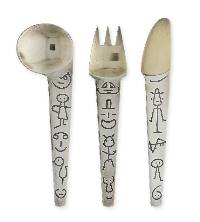
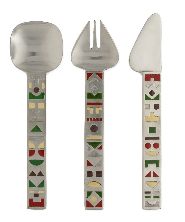
Child's flatware set, Gustav Ebl, Solingen,
silver-plated, circa 1960/61 (left)
Child's flatware set, Carl Mertens, Solingen,
stainless steel, 1962 (right)
|
Rodenkirchen's relationship with the Solingen flatware firms
was rather rocky. Many of his designs were executed yet a number
of firms failed to pay the small design honorary which led to
many court cases. A number of his designs were reproduced
without his authorization or monetary benefit, which contributed
to Rodenkirchen’s bitter feeling towards the industry. These
were the main reasons why he stopped designing flatware from the
middle 1970s on and concentrated on other projects.
The exhibition comprehensively tells the story of Rodenkirchen's
contribution to modern flatware design. The richly illustrated
catalogue of the exhibition, written by Averwerser/Müller-Daehn,
is the next best thing to seeing the exhibition in person and is
available from the Deutsche Klingenmuseum, Solingen
(note 7).
All photos courtesy of Badisches Landesmuseum, Karlsruhe, Paul
Foster and Heinrich Averwerser.
Dorothea Burstyn is the Editor of the Silver Society
of Canada Journal
and Administrator of SSC website
http://www.silversocietyofcanada.ca
- 2011 -
|
|
|






















